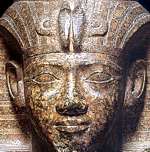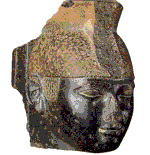| 25th Dynasty (194) 945-751BC | |
| For events in Nubia between the end of the New Kingdom and the early eighth century BC, evidence is extremely meagre. Although the suggestion that Lower Nubia was depopulated during this period is probably an exaggeration, the population may have been less prosperous than in earlier times and perhaps reverted to a semi-nomadic economy or migrated to the more prosperous south. Sporadic references to viceroys of Kush during XXIst-XXIIIrd Dynasties indicate that some Egyptian pretensions to authority there were maintained, and elements of royal titularies and formal epithets from temple inscriptions in Egypt have been adduced as supportive evidence for an aggressive policy to regain Upper Nubia - but, if this were the case, there was no lasting effect. By the mid-eighth century the chieftains of Napata, the centre of the cult of Amun in Nubia, had become overlords of Nubia and were already entertaining pretensions to rule Egypt as well. The office of Divine Adoratrise of Amun becomes more and more important and royal daughters and sisters at Theban throne hold rule equally powerful as royal power. | |
|
Piankhy |
|
|
King
of Napata, son and successor of Kashta. Came into possession of
Upper Egypt and founded the XXV Egyptian Dynasty, named also Kushite
or Napata Dynasty. After Tefnakht’s expedition he defeated Nimlot,
the Tefnakht’s ally, crushed fleet of the Egyptian king and
conquered Hermopolis. Coalition of northern kings, organized against
Kushite king, apart from Tefnakht and Nimlot from Hermopolis
included also prince Osorkon IV, Iupet
II
and Sheshonq
V.
Piankhi accepted tribute from all princes after defeating their
garrisons in main cities, including Memphis. After religious
celebrations in temple of Ptah at Memphis and Atum at Heliopolis, he
returned to Napata from where he ruled over Egypt.
Burial
place pyramid at el-Kurru. Other Datings 752-717 (Dodson) |
|
|
Shabako |
|
 Son
of Kashta and Pabatma.
After suppressing a revolt risen by northern princes and burning
Bokchoris at a stake (according to Manetho) he ruled over Egypt. In
face of still growing in power Assirians he followed the
policy of his predecessors, which was mainly based upon intrigues
and making political alliances. Traces of Shabaka’s building
activities are found both at Delta and to the south, including
oases. Burial place
pyramid at
el-Kurru, some pieces of equipment are preserved. Son
of Kashta and Pabatma.
After suppressing a revolt risen by northern princes and burning
Bokchoris at a stake (according to Manetho) he ruled over Egypt. In
face of still growing in power Assirians he followed the
policy of his predecessors, which was mainly based upon intrigues
and making political alliances. Traces of Shabaka’s building
activities are found both at Delta and to the south, including
oases. Burial place
pyramid at
el-Kurru, some pieces of equipment are preserved.
Other Datings 717-703 (Dodson) |
|
|
Shebitku |
|
|
Son
of Shabaka and father of Tenutamen.
His policy against Assiria was entirely more aggressive than that of
his predecessors. He headed the army which set out in support of
Jerusalem. In 701 BC antissirian coalition was defeated by Sanheryb
at Eltekeh in Palestine. Hezekiah of Judah surrended to Assiria and
paid heavy tribute to avoid ravage of Jerusalem. The Old Testament
suggests that a plague in Assirian army saved Egyptians and
Hebrevians from complete defeat. Herodotus in turn tells that
retreat of Assirians was due to swarms of mice who ate up their
weapon. Building activities of Shabataka are most pronounced at
Thebes (chapel by Holy Lake at Karnak and reliefs at Luxor) but also
at Memphis and Kawa. Burial place pyramid 18 at el-Kurru. Some
pieces of funerary equipment, skull and bones of Shabataka were
found. Other Datings 705-690 (Redford) |
|
|
Taharka |
|
 Son
of Piankchi and Abale. He is regarded as a ruler who re-united the
Land. At that time the prince and actual ruler of Thebes was
Montuemhat – the fourth prophet of Amun. Taharqa
rebelled at Sydon in 677 BC which caused Ashaddon’s campaign as a
result of which Lower Egypt fell into Assirian possession while
Taharqa
escaped to Thebes. In 669 BC Taharqa
regained the rule over Delta from local princes. Building
activities of Taharqa
refer to most splendid periods of Egyptian history and their traces
can be found all over the Land. Most known are: temples at Sanam,
Kawa, Atribis, Pnubs, Semna, Kasr Ibrim and numerous structures at
Karnak and Theban district. Burial place probably pyramid at
Nuri, although it can not be excluded that he was buried in
another place at Sedeinga, in pyramid-tomb where blocks with the
name of Taharqa
and corpse of 50 years old man were discovered. Son
of Piankchi and Abale. He is regarded as a ruler who re-united the
Land. At that time the prince and actual ruler of Thebes was
Montuemhat – the fourth prophet of Amun. Taharqa
rebelled at Sydon in 677 BC which caused Ashaddon’s campaign as a
result of which Lower Egypt fell into Assirian possession while
Taharqa
escaped to Thebes. In 669 BC Taharqa
regained the rule over Delta from local princes. Building
activities of Taharqa
refer to most splendid periods of Egyptian history and their traces
can be found all over the Land. Most known are: temples at Sanam,
Kawa, Atribis, Pnubs, Semna, Kasr Ibrim and numerous structures at
Karnak and Theban district. Burial place probably pyramid at
Nuri, although it can not be excluded that he was buried in
another place at Sedeinga, in pyramid-tomb where blocks with the
name of Taharqa
and corpse of 50 years old man were discovered.
|
|